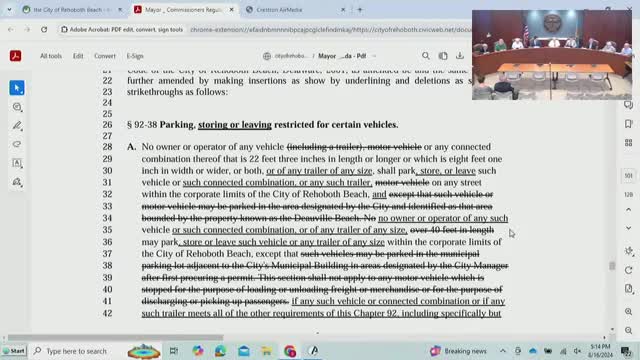Community Divided Over Controversial Trailer Regulations
August 17, 2024 | Rehoboth Beach, Sussex County, Delaware
This article was created by AI summarizing key points discussed. AI makes mistakes, so for full details and context, please refer to the video of the full meeting. Please report any errors so we can fix them. Report an error »

During a recent government meeting, officials engaged in a heated discussion regarding proposed regulations on the use of trailers in residential areas. The conversation highlighted concerns about aesthetics, construction timelines, and the potential impact on contractors and residents.
One commissioner expressed skepticism about the readiness of the proposed regulations, suggesting they were rushed and difficult to enforce, particularly regarding the aesthetics of trailers. The commissioner noted that while some trailers are well-maintained, others are considered unsightly, complicating the ability to legislate their appearance.
Concerns were also raised about the implications for contractors, particularly regarding the limited time allowed for trailers to be on construction sites. Currently, the code permits trailers to remain for only 30 days within a six-month period, which some officials argued is insufficient given that home construction can take up to 240 days. The financial burden of seeking extensions from the board of adjustments, which costs $1,000 each time, was also a point of contention.
The discussion further delved into the issue of trailers parked on public versus private property. While some officials believed that regulating trailers on public property could be straightforward, they acknowledged the complexities of enforcing rules on private property. The conversation revealed a shared frustration over a specific trailer that had been a persistent eyesore in the community, prompting calls for clearer definitions and regulations.
Several commissioners emphasized the need to address community standards and the ongoing complaints from residents about trailer nuisances. They expressed a desire to find a balanced approach that would allow for reasonable use of trailers while maintaining the aesthetic integrity of the neighborhood.
As the meeting progressed, officials recognized the importance of moving forward with regulations that would address the concerns of constituents without overreaching. The dialogue underscored the challenges of creating effective legislation that satisfies both the needs of residents and the realities of construction practices. The meeting concluded with a commitment to refine the proposed regulations and continue discussions in future sessions.
One commissioner expressed skepticism about the readiness of the proposed regulations, suggesting they were rushed and difficult to enforce, particularly regarding the aesthetics of trailers. The commissioner noted that while some trailers are well-maintained, others are considered unsightly, complicating the ability to legislate their appearance.
Concerns were also raised about the implications for contractors, particularly regarding the limited time allowed for trailers to be on construction sites. Currently, the code permits trailers to remain for only 30 days within a six-month period, which some officials argued is insufficient given that home construction can take up to 240 days. The financial burden of seeking extensions from the board of adjustments, which costs $1,000 each time, was also a point of contention.
The discussion further delved into the issue of trailers parked on public versus private property. While some officials believed that regulating trailers on public property could be straightforward, they acknowledged the complexities of enforcing rules on private property. The conversation revealed a shared frustration over a specific trailer that had been a persistent eyesore in the community, prompting calls for clearer definitions and regulations.
Several commissioners emphasized the need to address community standards and the ongoing complaints from residents about trailer nuisances. They expressed a desire to find a balanced approach that would allow for reasonable use of trailers while maintaining the aesthetic integrity of the neighborhood.
As the meeting progressed, officials recognized the importance of moving forward with regulations that would address the concerns of constituents without overreaching. The dialogue underscored the challenges of creating effective legislation that satisfies both the needs of residents and the realities of construction practices. The meeting concluded with a commitment to refine the proposed regulations and continue discussions in future sessions.
View full meeting
This article is based on a recent meeting—watch the full video and explore the complete transcript for deeper insights into the discussion.
View full meeting
